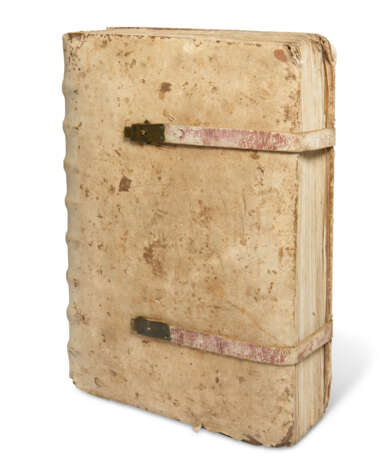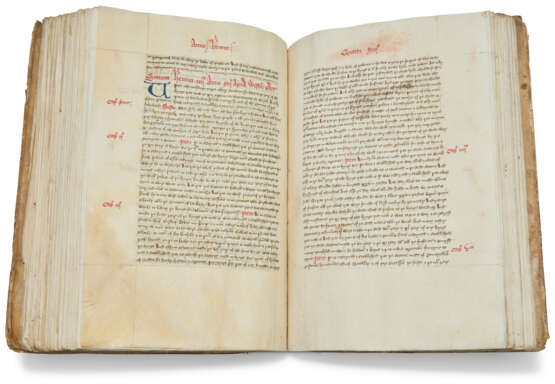ID 1214850
Lot 39 | Middle English Statutes
Valeur estimée
£ 120 000 – 180 000
Statutes of England, from 1 Edward III to 23 Henry VI, in Anglo-Norman French and Middle English, and the Modus Tenendi Parliamentum, in Latin, decorated manuscript on vellum [England (London or Suffolk?), mid 15th century (after 1445)]
A huge, exceptionally handsome compendium of English Law, containing more than 10,000 lines of Middle English, 'the work of first-class professional scribes, the first of whom signs his name'. One of only four copies, in its original unrestored 15th-century binding; from the famed Tollemache library at Helmingham Hall.
350 × 240 mm. 274 leaves, lacking 3 at the beginning and perhaps 3 at the end, otherwise complete, collation: 15 (of 8, lacking i–iii, vi now bound before iv), 2–38; 4–138; alpha-numeric leaf signatures in two series, starting at the Index (gathering 1) and the Middle English section (gathering 14), the second series of gatherings also with catchwords, written probably by more than one scribe, typically with 32–38 lines per page, ruled space: c.225 × 150mm, headings in red, large initials in blue, ornamented with fine penwork flourishing forming partial borders at the beginning of each of the five reigns (the outer or lower margins of about 35 leaves excised, otherwise with wide margins, a few stains and minor blemishes, but generally in fine condition).
Binding:
Contemporary binding sewn on eight bands laced into thick wood boards covered with undecorated tawed leather (probably originally pink), two strap-and-pin clasps fastening from the back to the front board (apparently unrestored).
Provenance:
(1) Signed by the scribe Richard Chetylbere (f.90v), perhaps a member of the Suffolk Chedburgh family.
(2) Signed by ‘Anna Wylbraham’, 16th century (f.273v); Great Wilbraham is a little to the east of Cambridge, and about 15 miles/25km west of Chedburgh.
(3) Edward Odiern, c.1575: inscribed ‘Memorandum that John Ive alias Sperhauke hath promised at his next commynge which must be at [...?] next quod eris in anno domini 1576 except godes visitation & the Quenes lett to bring and gyve me Edward Odiern […]’, below which is ‘Per me Edouardum Odyern’. A Nicholas and a Thomas Odyern were admitted to Gray’s Inn in 1580; an Edward Odiern, of Frating, Essex, was charged in 1597 with armed entry into the house of another man; and the will of a John Sperhauke, of Rivenhall, about 20 miles/30km from Frating, was made in 1600.
(4) John Barker, of Sibton, Suffolk, late 16th century: given to him by Odierne on 10 October 1592; inscribed, ‘Teste Johanne Barker Siptonensi Et datus erat [...?] predicto Johanne per prefatum Edwardum Hodierne Decimo die Octobris 1592 [added:] per me Edwardum Hodierne’ (f.2).
(5) Lionel Tollemache, 1st Baronet, of Helmingham Hall, Suffolk (about 15 miles/25km south-west of Sibton), who formed the collection of manuscripts at Helmingham c.1600: with the Helmingham shelfmark on the usual paper label in the upper outer corner of the front pastedown, ‘L.J.V.8.’ (cf. the blogpost for 18 March 2015 at mssprovenance.blogspot.com), altered in pencil to ‘L.J.III’; listed in the First Report of the Royal Commission on Historical Manuscripts (1874), Appendix, p. 61; by descent and remaining in the library until sold at Sotheby’s, 8 July 1970, lot 67; bought by:
(7) Charles W. Traylen, of Guilford: catalogue 77: Rare and Valuable Books and Manuscripts (1972), no 26, pl. 17, priced £1,100.
(8) B.J. Webb, Brisbane, Australia.
(9) Sam Fogg Rare Books, London; bought by:
(10) The Schøyen Collection, MS 1355.
Content:
(ff.1–21v) Abbreviation of the Statutes, in Anglo-Norman: an alphabetical index of Statute law as far as 23 Henry VI
(ff.22–90v) Statutes for 1 Edward III – 50 Edward III, chapter 8, in Anglo-Norman
(ff.91–94v) Modus Tenendi Parliamentum, in Latin, a concise summary of parliamentary procedures, starting with how a parliament may be summoned
(ff.95–101v) Statutes for 12, 18, 21, 28, 35 Edward Ill, and 2 Richard II, in Anglo-Norman
(ff.102–150v) Statutes for 1–20 Richard II, in Middle English
(ff.150v–151) Statutes for 21 Richard II, in Anglo-Norman
(ff.151v–179) Statutes for 1–13 Henry IV, in Middle English
(ff.179–199v) Statutes for 1–9 Henry V, starting in Anglo-Norman but switching into English within chapter 8, 2 Henry V (f.186v)
(ff.200–274v) Statutes for 1–20 Henry VI in Middle English, and 23 Henry VI (1445) in Anglo-Norman, ending in chapter 12 at ‘[...] un femme laborer & autres’.
There are approximately 165 leaves of Middle English, and at an average of about 35 lines per page, this suggests a total of more than 11,000 lines.
This is one of only four copies with such substantial Middle English contents; the others are Cambridge, University Library, MS Ff.3.1, to which the present manuscript is most closely related; British Library, Add. MS 81292 (formerly Christie's, 16 November 2005, lot 19); and British Library, Harley MS 4999. The first two include 20 Henry VI (1442) but not the next enrollment at parliament, 23 Henry VI (1445); the other one is on paper, incomplete, and was probably written c.1470–85. They are discussed by Kathleen E. Kennedy, ‘Prosopography of the Book and the Politics of Legal Language in Late Medieval England’, Journal of British Studies, 53 (2014), pp. 565–87. She notes that ‘Statute collections are our largest textual data set for late medieval England, and they have gone almost without study. This lack of examination has deprived scholarship of crucial scribal, artistic, and ownership evidence that may link owners of statute collections with networks of book artisans who worked on more storied, and therefore more studied, literary works’ (pp. 568–9).
The text has been corrected in a number of places. In the statute for 1 Henry VI, c.3, for example, to the passage, ‘For that diverse homicides, murdres, ravishyngs of women, robbers & other felonies & riotts conventicles now late have ben doon in dyverse countees of Englonde by folke born within ye grounde of Irlonde reparynge to the town of Oxenford […]’, is added between the lines: ‘and those abydynge undir ye iurisdiction of ye universite of Oxenford’. This wording can be compared with the earliest printed editions of the statutes in English, published a century later, which read: ‘Forasmuch as dyvers manslaughters, murders, rapes, roberies, & other felonyes, ryotes, conventicles, and dyvers other offences […]’.
A more detailed description of the manuscript and its texts, prepared by Jeremy Griffiths in 1991, is available on request.
| Lieu d'origine: | Angleterre, Europe du Nord, Europe, Royaume-Uni |
|---|---|
| Catégorie maison de vente aux enchères: | Manuscrits médiévaux et de la Renaissance, Livres et manuscrits |
| Lieu d'origine: | Angleterre, Europe du Nord, Europe, Royaume-Uni |
|---|---|
| Catégorie maison de vente aux enchères: | Manuscrits médiévaux et de la Renaissance, Livres et manuscrits |
| Adresse de l'enchère |
CHRISTIE'S 8 King Street, St. James's SW1Y 6QT London Royaume-Uni | |
|---|---|---|
| Aperçu |
| |
| Téléphone | +44 (0)20 7839 9060 | |
| Commission | see on Website | |
| Conditions d'utilisation | Conditions d'utilisation |















